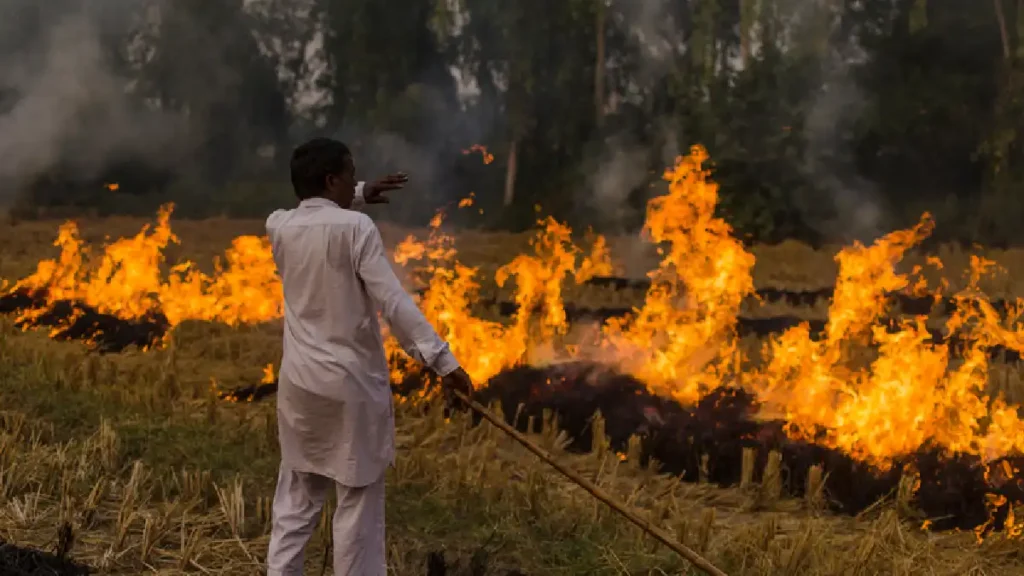32 Farm Fires In Punjab: What Is Stubble Burning In Punjab?
In delving into the concerning issue of active paddy stubble-burning cases, it becomes evident that the public’s curiosity is piqued, as they scour the vast expanse of the internet seeking details and updates on this pervasive matter. It’s not merely an informational quest; it’s a collective awareness fueled by the virality of news surrounding these incidents. This article seeks to satiate this hunger for knowledge by providing a comprehensive overview of the active cases of paddy stubble-burning.

What Is Stubble Burning In Punjab?
To comprehend the gravity of the situation, it’s imperative to understand the practice of stubble burning in Punjab. Faced with minimal time to reclaim their fields, farmers resort to setting fire to the farms to clear the residue. The repercussions of this agricultural practice are profound, contributing to environmental concerns and public health issues. The urgency of the matter is underscored by the recent statistics indicating 32 active occurrences of paddy stubble fires in Punjab within a ten-day span.
Monitoring stations, attuned to the environmental fallout of these incidents, have recorded pollution levels categorized as “moderate.” This indicates a delicate balance, one that hovers between acceptable and concerning thresholds. Notably, Saturday saw a decrease in reported cases, with only 32 instances recorded—a relatively lower figure compared to the preceding ten days. The nuanced nature of this issue becomes apparent when examining data from Punjab Remote Sensing Centre’s (PRSC) satellite images, which reveal fires in only seven out of 23 districts.
As of October 7 this year, the cumulative count of active fires stands at 877, signifying the pervasive and persistent nature of this problem. Amritsar, a city grappling with 537 reported occurrences of stubble burning, recorded fourteen instances on the aforementioned Saturday. Similarly, Kapurthala, Tarn Taran, and Patiala each reported four instances of field fires, highlighting the widespread impact across various regions.
Comparing the statistics of 2022 with the preceding year, a stark reality emerges. Up to October 7, there were 392 fewer fires this year, indicating a concerning upward trend. Amritsar, leading in reported cases, reflects a scenario where 537 instances have been documented so far this year, with Tarn Taran following closely with 120 cases. Amidst these incidents, the Air Quality Index (AQI) in Amritsar on Saturday stood at 70, categorizing it as “satisfactory.” However, Ludhiana and Rupnagar, both with “moderate” AQIs at 179 and 164, respectively, underscore the broader implications of stubble burning on air quality.
Centralized data from the Indian Institute of Agricultural Research (IIAR), supported by the agriculture ministry, paints a disconcerting picture. Stubble burning cases increased by 30% between September 15 and October 4 compared to the same period last year. This surge is attributed to paddy harvesting, a crucial agricultural activity that commenced about a fortnight ago. Punjab, with 656 reported cases, leads the tally, followed by Haryana with 166 cases. The ripple effect is felt across other states, with 74 cases in Uttar Pradesh, 47 in Madhya Pradesh, 45 in Rajasthan, and even one in Delhi.
The urgency of addressing this issue cannot be overstated. Environmental sustainability, public health, and the overall well-being of the affected regions are at stake. As we navigate through this article, it serves not only as an informative piece but also as a call to action. Stay connected with us for the latest updates on this pressing matter as we collectively strive for a sustainable and healthier future.
In this piece, we delve into the pressing issue of active cases of paddy stubble-burning, a matter that has captivated the public’s attention and spurred a surge in online searches. The public, in its quest for knowledge, has been scouring the internet to glean insights into the prevalent instances of paddy stubble-burning, seeking not only an understanding of the current landscape but also yearning for the latest updates as the news surrounding this phenomenon goes viral across digital platforms. In response to this information hunger, we aim to provide a comprehensive account of the ongoing cases and recent developments, serving as a valuable resource for our readers.
The agricultural landscape in Punjab is currently marred by the practice of stubble burning, a consequence of farmers grappling with limited time to reclaim their fields. In a bid to expedite the clearing of residue, they resort to setting fire to their farms. The recent statistics paint a concerning picture, with Punjab recording 32 active occurrences of paddy stubble fires in the span of ten days. The monitoring stations have flagged these incidents, noting that pollution levels are categorized as “moderate.” This observation serves as a snapshot of the environmental impact of these farm fires.
Interestingly, Saturday saw a decrease in the number of reported paddy stubble burning incidents in Punjab, with 32 cases being the lowest recorded in the rural northern region over the past 10 days. Notably, seven out of eight monitoring sites in Punjab reported pollution levels remaining in the “moderate” range. Satellite images from the Punjab Remote Sensing Centre (PRSC) revealed that fires were detected in only seven out of the 23 districts. Cumulatively, the data up to October 7 this year indicated a total of 877 active fires.
Digging deeper into the regional breakdown, Amritsar took the lead on Saturday with fourteen instances of burning paddy stubble, followed by Kapurthala, Tarn Taran, and Patiala, each recording four instances of field fires. The PRSC data further underscores the year-on-year comparison, revealing that there were 392 fewer fires up to October 7 in 2021 than there were in 2022 (692). The numbers present a nuanced narrative of the prevailing situation, signaling fluctuations in the occurrence of these concerning fires.
The air quality index (AQI) on Saturday in Amritsar, a region significantly impacted by stubble burning, stood at 70, falling within the “satisfactory” range. However, Ludhiana (179) and Rupnagar (164) were marked as the two “moderate” cities with comparatively poorer air quality indexes. This data serves as a crucial barometer of the environmental implications of stubble burning, reflecting on the broader impact on air quality in the affected regions.
Delving into broader national statistics, data from the Indian Institute of Agricultural Research (IIAR) reveals a worrisome 30% increase in stubble burning cases between September 15 and October 4 compared to the same period last year. This surge is attributed to the ongoing paddy harvesting activities that commenced approximately two weeks ago. Punjab takes the lead in the number of stubble-burning incidences with 656 cases, followed by Haryana with 166. Other affected states include Uttar Pradesh (74 cases), Madhya Pradesh (47 cases), Rajasthan (45 cases), and Delhi (1 case). These figures highlight the widespread nature of the issue, extending beyond regional boundaries.
In the broader context of time, statistics collected up until October 4 underscore a comparative decrease in the number of fires in 2021 (692) compared to 2022 (877). This temporal comparison sheds light on the evolving nature of stubble burning occurrences, suggesting a potential trajectory that warrants vigilant observation.
As the situation unfolds, we commit to keeping our readers abreast of the latest developments in this dynamic landscape. Stay tuned with us for real-time updates on the active cases of paddy stubble-burning and the consequential environmental impacts. Our endeavor is to provide a nuanced and comprehensive understanding of this critical issue that resonates with the concerns and inquiries of our discerning audience.







